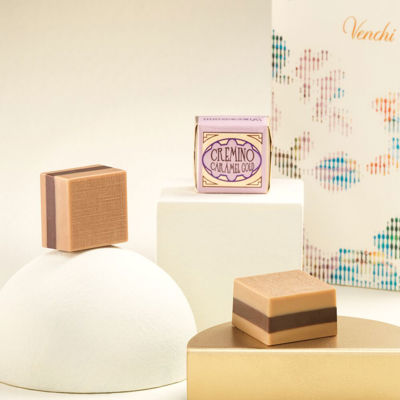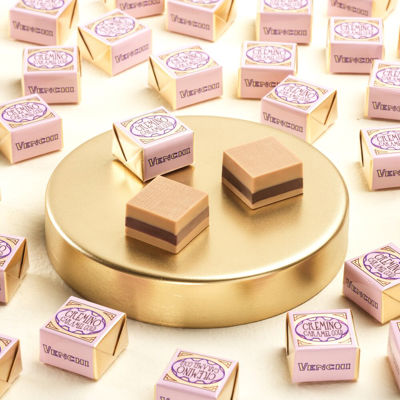
What is caramel made of?
With its golden hue and rich flavor, caramel is one of the most beloved confectionery ingredients. But how is it made, exactly? Explore caramel’s colorful history and how it differs from chocolate: let’s find out the secrets behind its irresistible flavor, and much more.
Venchi Caramel Chocolate
When and where was caramel invented?
Caramel's history is elusive, but some trace it back to the Arabs around 1000 A.D., who boiled sugar into a crunchy confection called “kurat al milh” or “sweet ball of salt”.
It gained popularity in 19th-century America, where milk and butter were added to create chewy caramel candies. In the 1970s, French pastry chef Henri Le Roux invented salted caramel, now a beloved treat worldwide.
What is caramel, exactly?
You've enjoyed it in chocolate or drizzled over desserts, but what exactly is caramel? Sticky and rich, caramel is made when sugar is slowly heated until it liquefies and releases a deep, buttery flavor—usually around 340°F.
What is caramel made of? At its simplest, dry caramel can be created solely from sugar, any type from white to brown. Wet caramel heats sugar and water together, allowing it to caramelize. To make fillings or sauces, many chefs add milk and butter to the caramel to enhance its flavor and creaminess.
How to describe caramel's flavor against chocolate?
Caramel and chocolate are both sweet delicacies, yet they’re different in terms of ingredients, cooking methods, taste, and texture. Even though they’re often paired together to create irresistible caramel chocolate, such as Venchi’s.
Caramel is a perfect example of how simplicity in the kitchen can deliver the most exciting flavors. Often made from just sugar, caramel has a multi-dimensional taste that balances buttery, nutty, and sweet flavors with just the right hint of bitterness. Its texture can vary depending on how it's prepared; it can be a smooth, liquid, and also a soft, chewy candy.
Chocolate’s star ingredient is the cocoa bean, which is usually blended with cocoa butter, sugar, and milk solids for milk and white chocolate. Chocolate has its own distinctive cocoa flavor, and it is often solid at room temperature and melts in your mouth.
How is caramel used in cuisine?
Caramel is highly versatile and can be used in a variety of dishes. Here are the most popular ones below:
Dessert toppings: caramel sauce is delicious drizzled over ice-creams, cakes, pies and puddings. You can use it to bring a rich, juicy element to almost any dessert.
Caramel candy: the chewy version of caramel can be widely found in caramel candies, caramel-coated apples, and as the caramel filling in chocolates.
Baking filling: you can also bake caramel in the oven, and it’s often used to enhance the flavor of brownies and pies.
Drizzled in drinks: caramel syrup is a popular addition to hot chocolate drinks, milkshakes, and cappuccinos. It can also be used in chai lattes, often combined with cinnamon.
Which cultures use caramel the most
Caramel is a classic flavor with a long tradition, and it continues to grow in popularity worldwide. While it’s hard to pinpoint a single country as the top consumer, North America makes up 31% of the global caramel market, the largest share. In Western Europe, caramel ranks as the third most popular chocolate flavor, after hazelnut and almond. Below, we highlight some signature caramel dishes from different cultures to show just how widespread its appeal is.
America: caramel popcorn and butterscotch pudding
Britain: sticky toffee pudding
Australia: caramel slice
France: crème brûlée and tarte tatin
Pakistan: bal mithai, which is caramel flavored with saffron and cardamon.





